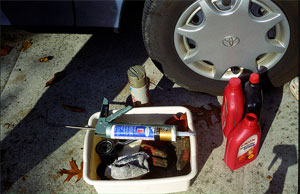How to Repair your Toyota Car on your Own?
 One cannot overlook the utility of vehicles, as they carry us through hundreds of miles without making excuses. So, it is our obligation to oversee the health of our automobile frequently. However, carrying repair and maintenance activities on regular intervals is not an easy deal. It requires effort, time, and above all, resources to ensure the fitness of your drive.
One cannot overlook the utility of vehicles, as they carry us through hundreds of miles without making excuses. So, it is our obligation to oversee the health of our automobile frequently. However, carrying repair and maintenance activities on regular intervals is not an easy deal. It requires effort, time, and above all, resources to ensure the fitness of your drive.
Toyota is undoubtedly, one of the most used car brands around the globe. Although it promises great comfort, speed and value, it still requires your attention towards its wellbeing. If you are having issues with your Toyota made vehicle and are restricted to visit the workshop, I have got a bunch of simple solutions for you. If you feel yourself helpless even after trying your best, have a ride to Pittsburgh Toyota Maintenance.
Described in this article, are some useful tips on how to repair your Toyota vehicle without the assistance of a professional. To identify the issue of your concern, consult the following.
Noisy Brakes: Are you annoyed of the weird sounds each time you apply the brakes, or it just misses sometimes when you push the brake pedal. It usually occurs due to components stuck with debris. Take your car for a washout or do it yourself with pressured water. Make sure to testify the integrity of significant components involved in the processing of this feature. In this regard, inspect brake rotors or discs, drums, pads, and belts. See if these are seated just the way as they should be. If you find any of these damaged, you may need to replace that.
Fuel Injection: It is an alarming situation, as the car would stay motionless without a proper fuel injection. This usually happens due to the fuel pump’s failure. Electric fuel pumps are in continuous action over years and are subject to undertake wear in brushes, pump vanes, gears, commutators, or rollers. To troubleshoot the situation, examine voltage supple to the pump and other electrical connections like fuse and wires. Make sure your battery isn’t running out of voltage.
Engine Knock: Although it is a trivial issue with little annoyances, it can grow to an upsetting problem, if not handled timely. To start with, check out the dipstick to know if the engine oil is on a proper level. It should neither be lower, nor overfilled. Inspect the engine from underneath to locate any oil leakages. A leaking engine however requires new seals and gaskets. In addition to that, check if the valve guides, rings, or cylinders are wearing. If yes, they also need a replacement.
Tune Up: Although it is an outmoded term, people around the world are still using it. This is a troubleshooting technique that mostly works, when you are facing a dropped down performance of your vehicle. Tune up you vehicle by inspecting all ignition parts including, spark plugs and their wire sets, distributor cap and rotor. Moreover, certain filters need to be substituted with the new ones as they go useless after an extent of mileage. These include: oil filter, breather filter, air filter, automatic transmission filter, and fuel filter.
The above noted troubleshooting techniques would definitely assist you in mending your own ride. However, I strongly recommend you to carry out a periodical maintenance check to avoid any inconveniences. Include in your checklist, the regular inspection of fluids including engine oil, grease, and other lubricants; check and ensure hoses; scrutinize the belts for even minor damages and replace them right away as they cost very low; and at last, thoroughly observe your Toyota engine against leakages. You can carry these checks once after a couple of weeks or even after a month. If the issue you are facing is unmanageable, take no time to bring it for a professional scan.
Image Credit: bcostin
























